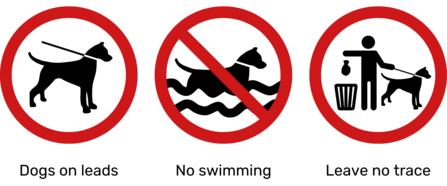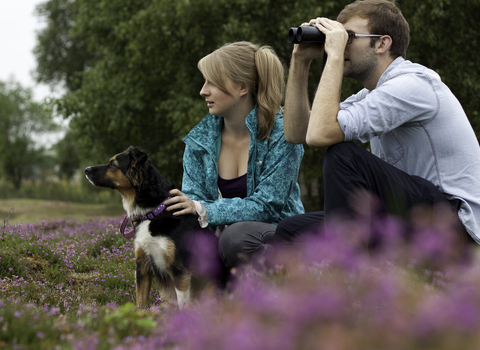Our nature reserves are precious havens for wildlife. As your local wildlife charity, we work hard to make them exceptional places for nature to thrive. That is why we ask dog owners to visit our reserves responsibly.
We believe everyone has the right to access and enjoy nature and, for many of us, having a dog encourages us to be more active and spend time outside. Dog owners are natural allies in much of what we do at the Trust, and many of our staff and volunteers are proud dog owners.
However, dogs and nature reserves aren’t always compatible.
Many birds nest or feed on the ground, where they’re vulnerable. Chemicals in flea treatments can leach into ponds, lakes and rivers. And dog poo - if it’s not picked up - adds harmful nutrients to the soil which can damage rare insects and plants. Lastly, we have unfortunately had incidents where dogs have killed wildlife.
On many of our nature reserves, dogs are not allowed because the species and habitats are too delicate. On the nature reserves where dogs are allowed, owners must keep their pets on a short lead, stick to the paths, and follow on-site signage to minimise disturbance to wildlife.

How dog owners can help
- Check our nature reserve webpages before you travel to find out if dogs are allowed;
- Keep your dog on a short lead at all times;
- Keep to the footpaths and marked trails;
- Keep your dog out of water to prevent flea treatments from poisoning rivers, ponds and lakes;
- Clean up after your dog and dispose of dog waste at home;
- Avoid visiting a nature reserve with large groups of dog.
Reporting incidents with dogs
Please call the police for any serious incidents or wildlife crimes involving dogs.
For non-serious incidents or concerns, please email teamwilder@suffolkwildlifetrust.org.
Further reading
- Pet flea treatments found in English rivers - The Guardian [Jun 2025] (https://www.theguardian.com/environment/2025/jun/17/dangerous-pesticides-pet-flea-treatment-detected-english-rivers)
- Flea treatments are an environmental hazard - The Guardian [Feb 2025] (https://www.theguardian.com/commentisfree/2025/feb/23/flea-treatments-cats-dogs-environmental-hazard)
- Dog-tracking study reveals disturbance to heaths - BirdGuides [Jan 2025] (https://www.birdguides.com/articles/conservation/dog-tracking-study-reveals-disturbance-to-lowland-heaths/)
- The Doggy Dilema by Ben McFarland - Wild Suffolk [Autumn 2022] (https://www.suffolkwildlifetrust.org/sites/default/files/2022-12/SWT%20Mag%20Sept%202022%20Dogs.pdf)
- Dog pee and poo harming nature reserves - The Guardian [Feb 2022] (https://www.theguardian.com/environment/2022/feb/07/dog-pee-and-poo-harming-nature-reserves-study)
- Dogs on Nature Reserves leaflet - Suffolk Wildlife Trust (https://www.suffolkwildlifetrust.org/sites/default/files/2022-06/Dog%20walkers%20leaflet%2027%20Sarah.pdf)

